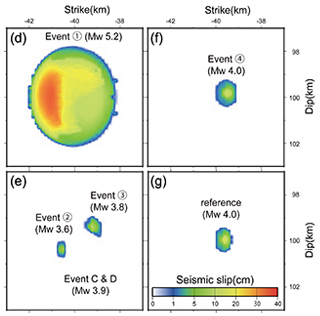Press Releases
December 16, 2014
JAMSTEC
Simulation Reproduced Repeating Earthquakes
Triggered by 2011 off the Pacific Coast of Tohoku Earthquake
~ Demonstrated Important Analytical Approach for Earthquake Prediction ~
1. Overview
Dr. Keisuke Ariyoshi, Research and Development Center for Earthquake and Tsunami, Japan Agency for Marine-Earth Science and Technology (JAMSTEC: Asahiko Taira, President) reproduced the characteristic of repeating earthquakes*1 off Kamaishi triggered by the 2011 off the Pacific Coast of Tohoku earthquake by conducting a large number of simulations using the Earth Simulator. Several model validations successfully demonstrated that the direction of postseismic slip (slow fault slip that continues after the earthquake) and frictional properties triggered by the 2011 off the Pacific coast of Tohoku earthquake could be estimated without using existing approaches such as rock fracture experiments and geodetic observations.
Understanding of the propagation direction of postseismic slip and frictional properties is an important clue to simulate not only repeating earthquakes but also megathrust earthquakes. However, it is difficult to detect them by land observations because many of plate boundaries around Japan are in the deep sea.
These approaches are expected to contribute to earthquake projection researches for other types of “repeating earthquakes” and megathrust earthquakes in the Nankai Trough.
These study results have been posted on the U.S. science journal, Geophysical Research Letters on December 16th, 2014 (JST).
Title: A trial estimation of frictional properties, focusing on aperiodicity off Kamaishi just after the 2011 Tohoku earthquake
Authors: Keisuke Ariyoshi1, Naoki Uchida2, Toru Matsuzawa2, Ryota Hino3, Akira Hasegawa2, Takane Hori1, and Yoshiyuki Kaneda4
1 Research and Development Center for Earthquake and Tsunami, Japan Agency for Marine-Earth Science and Technology
2 Research Center for Prediction of Earthquakes and Volcanic Eruptions, Graduate School of Science, Tohoku University
3 International Research Institute of Disaster Science, Tohoku University
4 Disaster Mitigation Research Center, Nagoya University
*1 Repeating earthquake: Earthquakes repeated almost the same interval and scale.

Figure 1: Bathymetric map showing the epicenters of repeaters off Kamaishi marked by the red star.

Figure 2: History of seismic activiies off Kamaishi

Figure 3: (c) Schematic view of the 3-D simulation model of a subduction plate boundary used for this study. Characteristic earthquake areas are set at three points with different distances.


Figure 4: (Upper left) Histories of slip velocity averaged within the asperity(a-b<0 in the fig.3). The black star indicates time when the large earthquake occurred. For the aging-law, activation due to postseismic slip can be reproduced while it becomes moderate for the slip-law. (Right upper) Slip velocity distribution on plate interface at the time of ①, ② and ③. The warm color shows high-speed slip, and the cool colors locked region. For reference, the slip velocity distribution is also shown in the interseismic stage of the megathrust earthquake. (Left below) Coseismic slip distribution around focal areas of characteristic earthquakes.

Figure 5: Epicentral distribution of earthquakes off Kamaishi after the 2011 off the Pacific Coast of Tohoku earthquake (shown gray background color in the fig.2).
It shows fluctuation in a direction between east-southeast and west-northwest.
Contacts:
- (For this study)
- Keisuke Ariyoshi, Senior Scientist, Research and Development Center for Earthquake and Tsunami
- (For press release)
- Kazushige Kikuchi, Manager, Press Division, Public Relations Department